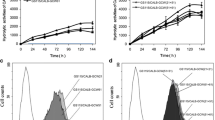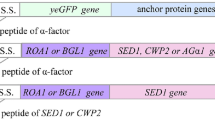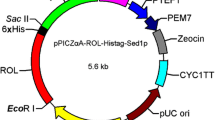Abstract
A novel system based on Pir1 from Saccharomyces cerevisiae was developed for cell-surface display of heterologous proteins in Pichia pastoris with the alpha-factor secretion signal sequence. As a model protein, enhanced green fluorescence protein (EGFP) was fused to the N-terminal of the mature peptide of Pir1 (Pir1-a). The expression of fusion protein EGFP-Pir1-a was irregular throughout the P. pastoris cell surface per detection by confocal laser scanning microscopy. A truncated sequence containing only the internal repetitive sequences of Pir1-a (Pir1-b) was used as a new anchor protein in further study. The fusion protein EGFP-Pir1-b was expressed uniformly on the cell surface. The fluorescence intensity of the whole yeast was measured by spectrofluorometer. Western blot confirmed that the fusion proteins were released from cell walls after mild alkaline treatment. The results indicate that a Pir1-based system can express proteins on the surface of P. pastoris and that the fusion proteins do not affect the manner in which Pir1 attaches to the cell wall. The repetitive sequences of Pir1 are required for cell wall retention, and the C-terminal sequence contributes to the irregular distribution of fusion proteins in P. pastoris.





Similar content being viewed by others
References
Abe H, Shimma Y, Jigami Y (2003) In vitro oligosaccharide synthesis using intact yeast cells that display glycosyltransferases at the cell surface through cell wall-anchored protein Pir. Glycobiology 13:87–95
Andres I, Gallardo O, Parascandola P, et al. (2005) Use of the cell wall protein Pir4 as a fusion partner for the expression of Bacillus sp. BP-7 xylanase A in Saccharomyces cerevisiae. Biotechnol Bioeng 89:690–697
Bony M, Thines-Sempoux D, Barre P, et al. (1997) Localization and cell surface anchoring of the Saccharomyces cerevisiae flocculation protein Flo1p. J Bacteriol 179:4929–4936
Castillo L, Martinez AI, Garcera A, et al. (2003) Functional analysis of the cysteine residues and the repetitive sequence of Saccharomyces cerevisiae Pir4/Cis3: The repetitive sequence is needed for binding to the cell wall beta-1,3-glucan. Yeast 20:973–983
Choi BK, Bobrowicz P, Davidson RC, et al. (2003) Use of combinatorial genetic libraries to humanize N-linked glycosylation in the yeast Pichia pastoris. Proc Natl Acad Sci U S A 100:5022–5027
Du C, Chan WC, McKeithan TW, et al. (2005) Surface display of recombinant proteins on Bacillus thuringiensis spores. Appl Environ Microbiol 71:3337–3341
Ecker M, Deutzmann R, Lehle L, et al. (2006) Pir proteins of Saccharomyces cerevisiae are attached to beta-1,3-glucan by a new protein-carbohydrate linkage. J Biol Chem 281:11523–11529
Gemmill TR, Trimble RB (1999) Overview of N- and O-linked oligosaccharide structures found in various yeast species. Biochim Biophys Acta 1426:227–237
Gunneriusson E, Samuelson P, Uhlen M, et al. (1996) Surface display of a functional single-chain Fv antibody on staphylococci. J Bacteriol 178:1341–1346
Kapteyn JC, Montijn RC, Vink E, et al. (1996) Retention of Saccharomyces cerevisiae cell wall proteins through a phosphodiester-linked beta-1,3-/beta-1,6-glucan heteropolymer. Glycobiology 6:337–345
Kapteyn JC, Van Den Ende H, Klis FM (1999) The contribution of cell wall proteins to the organization of the yeast cell wall. Biochim Biophys Acta 1426:373–383
Kondo A, Ueda M (2004) Yeast cell-surface display―Applications of molecular display. Appl Microbiol Biotechnol 64:28–40
Li Z, Xiong F, Lin Q, et al. (2001) Low-temperature increases the yield of biologically active herring antifreeze protein in Pichia pastoris. Protein Expr Purif 21:438–445
Matsumoto T, Fukuda H, Ueda M, et al. (2002) Construction of yeast strains with high cell surface lipase activity by using novel display systems based on the Flo1p flocculation functional domain. Appl Environ Microbiol 68:4517–4522
Mergler M, Wolf K, Zimmermann M (2004) Development of a bisphenol A-adsorbing yeast by surface display of the Kluyveromyces yellow enzyme on Pichia pastoris. Appl Microbiol Biotechnol 63:418–421
Mrsa V, Seidl T, Gentzsch M, et al. (1997) Specific labelling of cell wall proteins by biotinylation. Identification of four covalently linked O-mannosylated proteins of Saccharomyces cerevisiae. Yeast 13:1145–1154
Mrsa V, Tanner W (1999) Role of NaOH-extractable cell wall proteins Ccw5p, Ccw6p, Ccw7p and Ccw8p (members of the Pir protein family) in stability of the Saccharomyces cerevisiae cell wall. Yeast 15:813–820
Shi H, Wen Su W (2001) Display of green fluorescent protein on Escherichia coli cell surface. Enzyme Microb Technol 28:25–34
Shimma Y, Saito F, Oosawa F, et al. (2006) Construction of a library of human glycosyltransferases immobilized in the cell wall of Saccharomyces cerevisiae. Appl Environ Microbiol 72:7003–7012
Stahl S, Uhlen M (1997) Bacterial surface display: Trends and progress. Trends Biotechnol 15:185–192
Steidler L, Viaene J, Fiers W, et al. (1998) Functional display of a heterologous protein on the surface of Lactococcus lactis by means of the cell wall anchor of Staphylococcus aureus protein A. Appl Environ Microbiol 64:342–345
Sumita T, Yoko-o T, Shimma Y, et al. (2005) Comparison of cell wall localization among Pir family proteins and functional dissection of the region required for cell wall binding and bud scar recruitment of Pir1p. Eukaryot Cell 4:1872–1881
Takayama K, Suye S, Kuroda K, et al. (2006) Surface display of organophosphorus hydrolase on Saccharomyces cerevisiae. Biotechnol Prog 22:939–943
Tanino T, Fukuda H, Kondo A (2006) Construction of a Pichia pastoris cell-surface display system using Flo1p anchor system. Biotechnol Prog 22:989–993
Teparic R, Stuparevic I, Mrsa V (2007) Binding assay for incorporation of alkali-extractable proteins in the Saccharomyces cerevisiae cell wall. Yeast 24:259–266
Acknowledgments
This project was supported by a key fund from the Chinese Education Ministry (2005) and a grant from the National Natural Science Foundation of China (Grant No. 30470399).
Author information
Authors and Affiliations
Corresponding author
Rights and permissions
About this article
Cite this article
Wang, Q., Li, L., Chen, M. et al. Construction of a Novel Pichia pastoris Cell-Surface Display System Based on the Cell Wall Protein Pir1. Curr Microbiol 56, 352–357 (2008). https://doi.org/10.1007/s00284-007-9089-1
Received:
Accepted:
Published:
Issue Date:
DOI: https://doi.org/10.1007/s00284-007-9089-1




